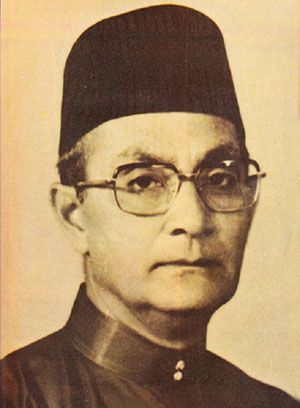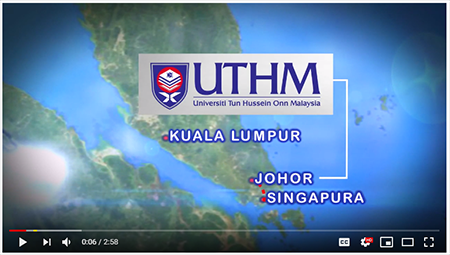Universiti Tun Hussein Onn Malaysia ( UTHM ) takes its name from a Malaysian statesman who was also the third Prime Minister of Malaysia , leading the country from 1976 to 1981. Born in Johor Bahru, Johor on February 12 , 1922 , he was the eldest son of Dato’ Onn bin Jaafar and Datin Halimah b inti Hussein. Tun Hussein received his early education in Singapore and later at the English College ( Maktab Sultan Abu Bakar ) in Johor Bahru. After leaving school , he joined the Johor Military Forces ( Angkatan Tentera Timbalan Setia Negeri Johor ) as a cadet in 1940 and was sent a year later to the Indian Military Academy in Dehradun , India , a famous military academy in the British empire at that time.
Upon completion of his training, he was commissioned in 1942. He then started his military career and was absorbed into the Indian Army ( Regimen Hyderabad ) in India. He served in the Middle East including Egypt , Syria , Palestine and Iraq and was promoted to the rank of Captain. With a deep spirit of heroism , he was also responsible in setting Malaya free from the Japanese occupation with the help of the Indian and British Armies. After the Second World War , his vast experience prompted the British to employ him as an instructor at the Malayan Police Recruiting and Training Centre in Rawalpindi , India.
In 1945 , Tun Hussein returned to Malaya and was appointed commandant of the Johor Bahru Police Depot. The following year , his military excellence continued when he joined the Malay Administrative Service and was appointed Assistant District Officer in Segamat , Johor. He was later posted to the state of Selangor , to serve as the District Officer of Klang and Kuala Selangor. However, he resigned from the civil service to go into politics. He was appointed as the first Youth Chief of the United Malays National Organization ( UMNO ) in 1949 and a year later, he was elected to the UMNO Secretary-General position. In addition, he also served as a member of the Federal Legislative Council and the State of Johor Legislative Council. However, when his father left UMNO in 1951 forming the Independent Malaya Party ( IMP ) , he also took the same move and joined him. With IMP losing momentum, he went to pursue his law studies at Lincoln’s Inn , London , qualifying as a Barrister-at-Law and when he came back , he served as a certified lawyer and practiced at the Skrine Firm and Company in Kuala Lumpur.
Tun Hussein returned to politics with success after success when he rejoined UMNO. He stood , contested and won the Parliamentary constituency of Johor Bahru Timur in the general elections in 1969. On September 22 , 1970 he was appointed as the Education Minister. He was filled with new ideas and among them was making it compulsory for students to pass Bahasa Malaysia in the public examinations in order to create the identity of the nation and to build unity among the communities. He also introduced the quota system for the entrance to public universities and initiated the foundation of Universiti Pertanian Malaysia. His meteoric rise continued when he succeeded the late Tun Dr. Ismail as the Deputy Prime Minister on August 13 , 1973 and later he was appointed as the Prime Minister of Malaysia on January 15 , 1976.
Tun Hussein had continued Tun Abdul Razak’s leadership policies which were the core policies to national development. In addition, he consolidated the previous policies by launching the National Unit Trust Scheme ( ASN ) in 1981 in order to increase the equity of the bumiputra community so that they could enjoy a fair share of the country’s economic wealth , consistent with the New Economic Plan ( DEB ). He also gave serious considerations to the concept of Rukun Tetangga ( a neighbourhood watch scheme ) and the launching of the Board of National Unity , Koperasi Usaha Bersatu and the Third Malaysian Plan. In addition, he fought against the drug menace with the launching of pemadam and he also fought against the communists by strengthening the armed forces.
Being a careful , thorough and disciplined person , Tun Hussein had succeeded in playing a significant role in solving problems that could harm the country’s safety. He would not tolerate anything that might threaten the peace , harmony and stability of the country or in other words he would not tolerate when the peace of the country was jeopardized by the subversive elements. With a modest but firm reputation , Tun Hussein Onn was renowned and looked upon as being very sincere in his struggle for racial unity in Malaysia. The title , ' Father of Unity ' given to him really matches the acronym of his first name , ‘ HUSSEIN ’ , which covers all the elements of unity to be achieved in the various communities in Malaysia.
The acronym is as shown below :
H Harmony
U Unity
S Security
S Survival
E Efficiency
I Integrity
N National
Tun Hussein had left good deeds which have been the essence of the administration of the Prime Ministers after him which stressed on the values of honesty , virtue and integrity towards building an excellent future. On May 29 , 1990 he passed away of a heart attack in Daly City , California , United States of America and his remains were buried at the Heroes Mausoleum, in the compound of the National Mosque in Kuala Lumpur. Al-Fatihah.



